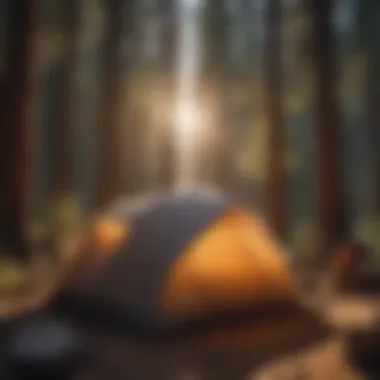Sequoia National Park Overnight Stay Guide


Intro
Sequoia National Park is a remarkable natural treasure, renowned for its towering trees and rich biodiversity. For those planning an overnight stay, understanding the landscape is vital. The following sections dive into the ecosystems that define this park and the essential practices for sustainability and stewardship. Each aspect aims to deepen your appreciation while ensuring responsible interactions with this unique environment.
Understanding Woodland Ecosystems
Woodland ecosystems are critical, serving as habitats for countless species, many of which are found nowhere else. This section provides insight into their importance and the role they play in global health.
Importance of Biodiversity in Forests
Biodiversity in forests enhances stability and resilience. Different species interact, forming a complex web that supports life. In Sequoia National Park, the presence of giant sequoias alongside other flora creates an ecosystem teeming with life.
- Over 1,200 species of native plants
- Habitat for diverse wildlife, including black bears and endangered species
- Contributions to medicinal research and agriculture
Role of Forests in Climate Regulation
Forests influence climate by regulating temperature and capturing carbon dioxide. They serve as important carbon sinks, helping mitigate climate change. In Sequoia, the trees sequester large amounts of carbon, which is essential in today’s environmental landscape.
- Act as temperature buffers in local climates
- Improve air quality through oxygen production
- Protect watersheds, crucial for avoiding natural disasters
Sustainable Forestry Practices
Sustainable forestry addresses the need to balance economic needs with environmental protection. At Sequoia, maintaining this balance is crucial for long-term health.
Principles of Sustainable Forestry
Sustainable forestry practices focus on maintaining the ecosystem while allowing for resource extraction. This includes selective logging and replanting efforts to ensure forests are not depleted.
- Monitoring tree health and growth rates
- Maintaining soil integrity and biodiversity
- Involving local communities in resource management
Case Studies of Successful Implementations
Looking at successful case studies provides insights into best practices. Forest management strategies from areas similar to Sequoia can be informative.
- Redwood National and State Parks: Integrated habitat restoration with visitor education.
- Yosemite National Park: Focuses on fire management as a restoration technique.
Woodland Stewardship Techniques
Stewardship in woodland areas involves proactive management to protect resources and promote biodiversity. This section discusses effective techniques that can benefit Sequoia.
Forest Management Plans
A robust forest management plan is fundamental for long-term health. This plan should account for different factors such as wildlife, fire risk, and visitor impact.
- Assessment of current forest conditions
- Set measurable targets for restoration
- Regularly assess and revise based on outcomes
Conservation Strategies
Implementing effective conservation strategies requires collaboration with various stakeholders. This ensures alignment toward common goals.
- Engage local communities in conservation efforts
- Protect critical habitats from development
- Monitor species populations and adapt strategies accordingly
"Preserving natural habitats is essential for future generations to experience the beauty of places like Sequoia National Park." - Conservation Expert
By understanding these components, visitors can enjoy their stay while ensuring the park remains a vibrant ecosystem for years to come.
Preamble to Sequoia National Park
Sequoia National Park stands as a testament to nature’s grandeur and resilience. This section aims to introduce readers to the essential characteristics that make Sequoia a vital destination for any overnight adventure. Understanding its unique offerings is crucial for both the enjoyment and stewardship of this magnificent area.
Sequoia National Park is not merely a collection of trees and mountains; it embodies a rich historical legacy intertwined with the natural beauty of the Sierra Nevada. Located in California, the park was established to preserve its towering trees, diverse ecosystems, and breathtaking landscapes. When visitors stay overnight, they immerse themselves in an environment that has been conserved over generations. This experience enhances the appreciation of all that nature has to offer.
Moreover, the park serves several key functions, touching upon recreation, conservation, and education. Each of these elements contributes to the overall experience of overnight stays, making it pivotal for visitors to understand the park’s significance. By appreciating Sequoia's history and ecology, individuals can engage more deeply with the landscape and become active participants in its preservation.


Planning Your Visit
Planning your visit to Sequoia National Park is crucial for a successful and enjoyable overnight stay. The park is renowned for its stunning natural beauty, towering sequoia trees, and rich biodiversity. Proper planning can greatly enhance your experience by ensuring you make the most of your time and resources.
When you plan your visit in advance, you consider various elements that can impact your trip. Weather conditions, for example, can vary. Knowing when to visit can help you find the best climate and optimal views. Additionally, understanding the park's layout aids in navigating its vast expanses. Most visitors are eager to explore popular sites like the General Sherman Tree or Kings Canyon. Pre-planning not only saves time but also enables more in-depth exploration of the less crowded trails.
Best Time to Visit
The best time to visit Sequoia National Park largely hinges on personal preference and desired activities. Spring and early summer are ideal for those who wish to witness blooming wildflowers and flowing waterfalls. The landscape is vibrant, and many trails are accessible, although some may remain snowy into late June.
Summer months attract a high volume of visitors due to pleasant weather and complete trail access. Even so, larger crowds mean that securing accommodations becomes more competitive. Early bookings become essential at this time. The fall offers a more tranquil atmosphere as the summer rush wanes, and the foliage begins to change, providing stunning vistas. Winter poses challenges, with certain areas becoming inaccessible due to snow but offers unique opportunities for those interested in winter sports.
Park Hours and Regulations
Understanding park hours and specific regulations is vital for a smooth visit. Generally, Sequoia National Park remains open year-round, but certain facilities and campgrounds operate seasonally. Visitor centers and campgrounds adjust their hours based on the season, which can affect access to essential services and information.
The National Park Service encourages all visitors to familiarize themselves with the following regulations:
- Campfire Restrictions: Be aware of any fire restrictions, especially during dry seasons.
- Wildlife Protection: It is essential to maintain a respectful distance from wildlife to avoid disturbing them and ensuring your own safety.
- Backcountry Permits: For those venturing into backcountry areas, permitting systems and additional regulations apply.
It is advisable to check the National Park Service website for up-to-date information on hours, events, and specific regulations, ensuring an informed visit to this remarkable natural resource.
"Sequoia National Park awaits those who come prepared, offering an unparalleled connection to nature."
Taking time to plan your visit will undoubtedly yield a more enriching experience as you explore all that Sequoia National Park has to offer.
Accommodations within the Park
Accommodations within Sequoia National Park are vital for enhancing the visitor experience. The park offers a variety of options to suit different preferences and requirements. Understanding these accommodations can help individuals select the most suitable option for their stay. From luxurious lodges to basic campgrounds, each choice carries specific benefits and considerations.
Lodges and Cabins
Staying at one of the lodges or cabins in Sequoia National Park provides a unique way to immerse oneself in nature without sacrificing comfort. The Wuksachi Lodge, for instance, offers rooms with stunning views of the surrounding trees and mountains. It serves as an ideal base for exploring the park. Lodges typically include amenities like dining facilities, heat, and running water.
Visitors appreciate the convenience of on-site dining, which allows for meals without the need to set up a camp kitchen. Additionally, being close to visitor centers can make it easier to access information about activities in the park. However, it is essential to book well in advance during peak seasons as availability can be limited.
Camping Options
For those who wish to engage more closely with nature, camping options are plentiful in Sequoia National Park. Campsites, such as those found at Potwisha Campground and Doris Lake Campground, provide areas to pitch tents or park RVs. Each campground offers its unique ambiance, with some situated near rivers or offering views of the stunning Sequoia trees.
Consider the following benefits of camping:
- Affordability: Campsites are generally more cost-effective compared to lodges.
- Nature Immersion: Camping allows for a full sensory experience of the park, including sounds and sights not easily accessible from lodges.
- Community: Campgrounds often foster a sense of community among visitors, enhancing the experience through shared stories and assistance.
However, it is important to review campground regulations and requirements, such as fire restrictions and waste disposal practices, to ensure a safe and enjoyable experience.
Backcountry Camping
For more adventurous souls, backcountry camping presents a chance to escape the more populated areas of the park. It involves hiking into the less accessible sections of Sequoia, allowing for unparalleled solitude amidst towering trees and rugged landscapes. Only seasoned campers are advised to attempt this, as it requires adequate preparation and knowledge of navigation.
A few critical elements to consider for backcountry camping include:
- Permits: Visitors need to obtain appropriate permits before embarking on backcountry trips. These can generally be acquired from ranger stations in the park.
- Self-Sufficiency: Campers must carry in all necessary supplies, including food, water filtration systems, and first aid kits.
- Safety Awareness: It is crucial to be aware of wildlife interactions and weather conditions, as the backcountry can present unpredictable challenges.
"The wilderness holds great power; respecting its boundaries is necessary for a safe adventure."
Backcountry camping provides an incredible opportunity to connect with Sequoia’s natural beauty, but it requires respect for the environment and readiness for self-reliance.
Preparing for an Overnight Stay
Preparing for an overnight stay in Sequoia National Park is a crucial step to ensure a safe and enjoyable experience amidst its breathtaking natural beauty. An effective preparation process not only enhances personal comfort but also allows for a deeper appreciation of the environment surrounding visitors. Getting ready involves understanding the climate, available amenities, and expected activities, which, when aligned with a thoughtful packing plan, contributes to a memorable stay.
Essential Gear
The right gear serves as the foundation for a successful overnight visit. First, a durable tent is essential, as weather conditions can change quickly. Select a model that withstands strong winds and moisture. Consider sleeping solutions; a comfortable sleeping bag suited for the temperatures typical of the season is necessary. If you are camping at higher elevations, ensure that your bag is rated accordingly. Sleeping pads can also enhance comfort and provide insulation from the cold ground.


Other vital items include layers of clothing, as temperatures can vary drastically throughout the day and night. Waterproof outer layers, along with base layers and insulation, will help to regulate warmth. Don't forget practical tools such as a multi-tool, headlamp, or flashlight with extra batteries, as well as a first aid kit that addresses common injuries or ailments.
Additional Useful Gear:
- Camp stove and fuel
- Biodegradable soap for cleaning
- Lightweight cookware
- Reusable water bottles or hydration systems
Food and Supplies
When it comes to food, preparation is key. Planning your meals ahead of time can prevent overpacking and ensure that you have nutritious options. Lightweight, non-perishable items like dehydrated meals, trail mix, and energy bars are popular choices. Fresh produce can also provide vital nutrients, but should be consumed early in the trip.
Besides the food, appropriate cooking supplies are necessary. A compact camp stove and basic pots or pans can facilitate meal preparation. Remember to bring all utensils, including a spork and a knife, as well as a portable cooler if you opt for fresh food products. Ensuring proper food storage is vital to avoid attracting wildlife; therefore, invest in bear-resistant containers and familiarize yourself with food storage regulations in the park.
Safety Considerations
Safety is paramount when staying overnight in a national park. First, familiarize yourself with the wildlife in the area. Understanding the behaviors of animals such as bears, mountain lions, and snakes is critical. Keep a safe distance and never approach or feed wildlife.
Another aspect of safety is awareness of the terrain. Be conscious of unstable trails and sudden weather changes that can include thunderstorms or snow. Navigating using maps or GPS devices is essential in this often rugged landscape. Always notify someone of your plans and expected return.
"Understanding safety protocols and environmental regulations not only benefits the individual, but also helps protect Sequoia National Park for future generations."
Carrying a portable satellite communicator or a personal locator beacon can also enhance safety by providing a means of contact in case of emergencies. These devices are particularly useful in remote areas where cell phone service is limited.
In summary, preparing for an overnight stay in Sequoia National Park involves meticulous planning regarding gear, food, and safety. This preparation not only improves comfort and enjoyment but also fosters respect for the stunning environment within the park.
Activities During Your Stay
Engaging in various activities during your stay at Sequoia National Park significantly enriches the overall experience. The park offers breathtaking landscapes, diverse ecosystems, and a multitude of avenues for exploration. Understanding the activities available can help visitors appreciate the natural beauty while maximizing their time in the park.
Hiking Trails
Popular Hiking Routes
Popular hiking routes like the General's Highway Trail and the Congress Trail lead visitors through stunning landscapes and provide a closer view of Sequoia's majestic trees. These trails are characterized by well-maintained paths, making them accessible to a range of fitness levels. The General's Highway Trail offers a moderate challenge and rewards with spectacular views of the famed Giant Sequoias. This accessibility is a key factor making these routes beneficial for both novice and experienced hikers.
The unique feature of these popular routes is their proximity to significant landmarks within the park, such as the General Sherman Tree, the world's largest tree by volume. However, it is essential to prepare for changes in climate and trail conditions, especially if hiking in the early morning or late afternoon when visibility may decrease.
Difficulty Levels
Understanding the difficulty levels of various trails is crucial for planning an enjoyable hike. Trails range from easy, such as the route to the Crystal Cave, to more challenging paths like the climb to Mount Whitney, the tallest peak in the contiguous United States. The key characteristic of these levels is that they cater to hikers of all abilities, allowing everyone to enjoy the park in a manner that suits their skills.
The unique feature here is that trail difficulty is often clearly marked, which allows for informed decision-making before embarking on a hike. Knowing the difficulty helps avoid potential physical strain or injury. Nonetheless, one should remember that what might be an easy trail for one person can be challenging for another, depending on physical condition and hiking experience.
Safety Guidelines
Adhering to safety guidelines while hiking in Sequoia is paramount. These patterns of behavior inform visitors of essential precautions to take. A key characteristic of these safety guidelines includes proper gear checks, informing someone of your plans, and staying on designated trails. It is critical to follow these recommendations to ensure a safe experience.
The advantage of these guidelines is that they significantly reduce the chances of accidents. For instance, bringing adequate water, food, and first aid supplies can make a hike not only safer but more enjoyable. However, it is worth noting that even experienced hikers can encounter unexpected challenges, making awareness and preparation essential.
Wildlife Observation
Common Species
Sequoia is home to a wide array of common species. Deer, black bears, and various bird species can often be spotted. Recognizing these species contributes significantly to enhancing the park experience as it allows insight into natural behaviors and habitats.
A distinctive feature of wildlife observation in the park is the opportunity to see animals in their natural environment, which can encourage conservationist values among visitors. However, one should respect the animals' space to avoid stress or harm to the wildlife, which could disrupt their natural activities.
Best Practices
Following best practices while observing wildlife ensures both personal safety and the well-being of animals. Staying a safe distance, avoiding feeding them, and not attempting to touch or provoke animals create a respectful interaction. The importance of these practices cannot be overstated, as improper behavior can endanger both the observer and the observed.
The advantage of adhering to best practices is that it promotes a sustainable and ethical approach to wildlife observation. This not only enriches the visitor experience but also fosters a sense of responsibility towards the natural environment.
Stargazing Opportunities


Under the clear night skies of Sequoia National Park, one can witness a spectacular display of stars. The absence of artificial lights makes it an ideal location for stargazing. Visitors can enjoy the Milky Way and various constellations.
The unique feature of stargazing here is its potential to inspire awe and deepen an appreciation for the universe. Just lying on the ground, gazing upward allows for personal reflections about life, nature, and place in the cosmos. However, one should be mindful of the colder night temperatures and come prepared to appreciate the experience fully.
Environmental Considerations
Understanding the significance of environmental considerations during your stay at Sequoia National Park is crucial. The park’s delicate ecosystems must be preserved and protected. This section outlines essential principles and precautions every visitor needs to acknowledge. Responsible practices enhance not only your experience but also safeguard the park’s natural beauty for future generations.
Leave No Trace Principles
The Leave No Trace principles guide outdoor enthusiasts in minimizing their impact on nature. They encompass a set of seven guidelines that include:
- Plan ahead and prepare: Knowledge about the area helps in avoiding unnecessary disturbances to wildlife and landscapes.
- Travel and camp on durable surfaces: Sticking to established trails and campsites prevents ecosystem degradation.
- Dispose of waste properly: Leaving no litter, packing out all trash, and using established restroom facilities aids in keeping the park clean.
- Leave what you find: Taking only pictures and leaving natural items undisturbed preserves the area’s integrity.
- Minimize campfire impact: Using a stove for cooking instead of a fire reduces the risk of wildfires and soil erosion.
- Respect wildlife: Observing animals from a distance ensures their natural behavior is not disturbed.
- Be considerate of other visitors: Staying quiet and respecting shared spaces contributes to an enjoyable experience for all.
By adhering to these principles, visitors contribute to the park's preservation. > "Every small action matters in maintaining the beauty of Sequoia National Park."
Wildlife Safety Precautions
Safety around wildlife is paramount for both visitors and animals. Understanding proper interactions with the park's diverse wildlife, including bears, deer, and various bird species, is essential. Here are vital precautions:
- Maintain distance: Always observe animals from a safe distance. Approaching wildlife can provoke stress or aggression.
- Store food securely: Use bear-proof containers and avoid leaving food unattended. This action is essential to deter bears and prevent unwanted encounters.
- Stay calm if encountering wildlife: Do not panic. Back away slowly if you come across wildlife unexpectedly. Make your presence known without shouting.
- Educate yourself about local species: Knowledgeable visitors are better prepared to recognize and respect the park’s inhabitants.
These precautions ensure the safety of visitors and the welfare of wildlife. Understanding and respecting the environment enhances the overall experience while visiting Sequoia National Park.
Cultural and Educational Opportunities
Understanding the cultural and educational opportunities within Sequoia National Park enhances the visitor experience. These aspects provide insight into the park's ecological significance and its role in the broader environmental context. Visitors can deepen their appreciation for the natural world through various activities aimed at fostering knowledge and respect for this majestic landscape.
Visitor Centers
Visitor centers serve as essential gateways to learning. At these centers, park rangers and knowledgeable staff provide educational resources about Sequoia National Park's flora, fauna, and geological features.
Important points include:
- Interpretive Displays: These often include information about the giant sequoias, local ecosystems, and conservation efforts.
- Interactive Exhibits: Engaging exhibits help visitors understand ecological principles in a more hands-on manner.
- Books and Materials: These resources can assist visitors in planning their activities while also enhancing knowledge about the park’s environment.
By stopping at visitor centers, guests gain valuable context to appreciate their surroundings more fully.
Guided Tours and Workshops
Guided tours and workshops offer structured opportunities to engage with naturalists and experts. These programs are designed to enhance understanding and foster a sense of stewardship among visitors.
Key benefits include:
- Expert Guidance: Tours led by knowledgeable guides provide insights that self-exploration may miss.
- Focused Learning: Topics can range from forest ecology to wildlife tracking. Participants can select tours that meet their interests.
- Hands-On Experiences: Workshops allow for direct interaction with nature, such as tree identification or photography techniques.
Overall, these offerings create memorable educational experiences.
"Engagement with nature through structured learning cultivates a deeper understanding and lasting appreciation for the environment."
Closure
Understanding the significance of an overnight stay at Sequoia National Park is crucial for maximizing the experience one can gain from this unique ecosystem. The article culminates in discussions highlighting various elements that impact the visit. From accommodation choices to engagement in activities, each section aims to provide a comprehensive overview, ensuring that readers can navigate the park effectively.
Reflecting on the Experience
After spending time in the breathtaking landscapes of Sequoia, visitors often find themselves reflecting on their connection to nature. This reflection can lead to a deeper appreciation of the complex ecosystems present in the park. Such experiences can foster a sense of stewardship, motivating individuals to engage in conservation efforts among their communities.
When visitors camp beneath the towering giants, they not only touch the earth but weave a relationship with the wilderness that extends beyond their stay. Witnessing the sun set over the mountains or the quiet majesty of the sequoias can evoke sentiments that often linger long after one has left. Documenting these experiences through journaling can serve as a reminder of nature’s profound influence on personal growth and ecological awareness.
Continuous Engagement with Nature
Engaging continuously with nature is paramount for fostering environmental awareness and personal wellbeing. Visitors are encouraged to utilize their time at Sequoia as a starting point for a lifelong journey of exploration and engagement with the natural world.
Sustaining a connection comes from activities such as joining local hiking clubs, participating in environmental workshops, or volunteering with conservation organizations. Online platforms, such as reddit.com, can also be fruitful for exchanging ideas and experiences.
Furthermore, it is beneficial to revisit local parks and natural reserves throughout the year. Seasonal changes reveal the dynamic nature of ecosystems, enhancing one’s understanding of biodiversity. Using resources like britannica.com or wikipedia.org can enrich this knowledge, allowing individuals to grasp the significance of their experiences and draw parallels to the broader environmental context.
"Nature is not a place to visit. It is home." - Gary Snyder
By reflecting on their experiences and seeking continuous engagement, individuals can create a sustainable relationship with nature, ensuring that the lessons learned from experiences at Sequoia National Park endure beyond their visit.







